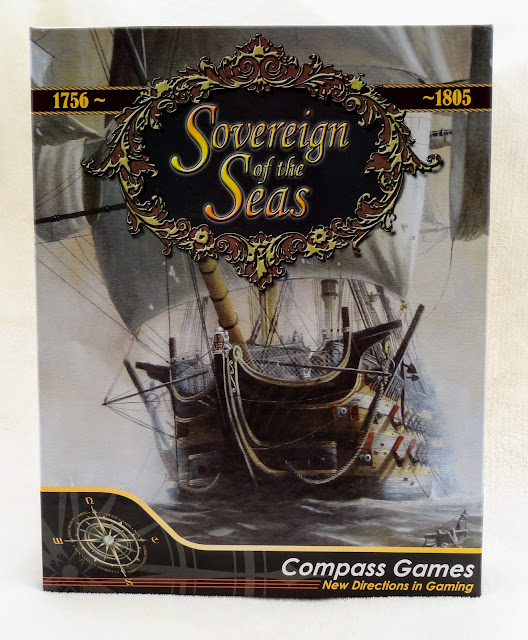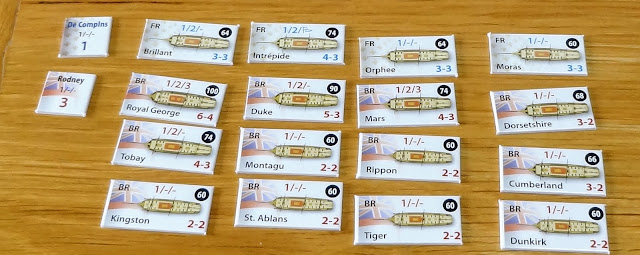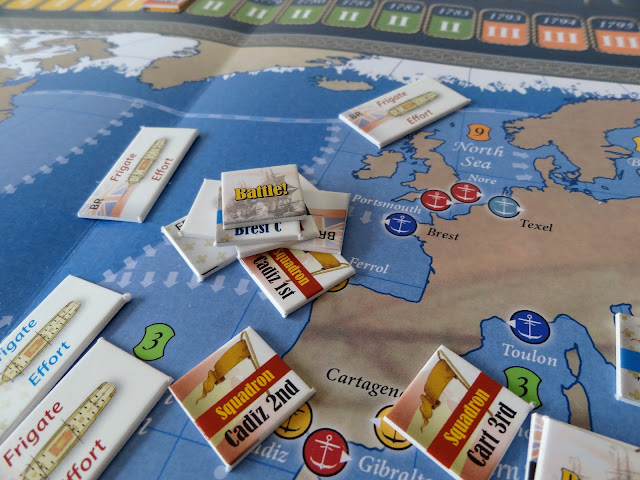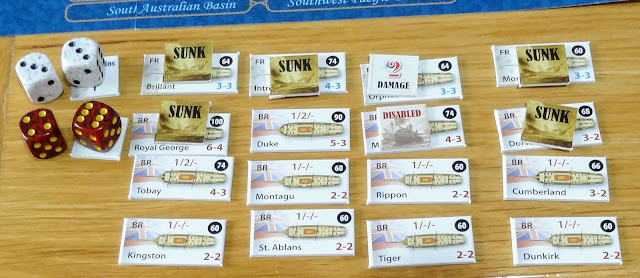 |
| Box front |
Sovereign of the Seas is a strategic 2 player naval wargame set during a 50+ year period of almost continual European and British conflict. Naval power was the ultimate weapon and a large slice of British pride and its' maritime tradition was laid down during this era. I have never tackled the age of sail in a boardgame and I was very much looking forward to reviewing Sovereign of the Seas.
The first thing that struck me upon receiving Sovereign of the Seas was the weight of the box, or lack thereof. It retails for £124.99 and it would be remiss of me not to say up-front that this game, the components, their quality do not make up a 125 pound game. I think I appreciate the fact that Compass Games - the publisher, serves a niche market within a niche hobby, which serves to make their per-unit costs much more expensive than other publishers. However, I cannot justify the RRP they're asking for it in Britain. Apparently it's ~ $85 across the pond and even then it's a tough sell.
For your money you get 1 rule book, 1 paper map (split into 2 tri-fold sheets), 6 sheets of counters, 7 sheets of card and 2 five millimetre dice. I am no stranger to paper maps or counter sheets but at this price I would expect mounted maps that butt up against each other and counters that come out cleanly. What you get instead, is two overlapping maps that need to be laid just right, and some pretty tough counters to push out cleanly. After the first counter sheet with a few tears, (that's tears of paper, not tears of anguish) I decided to pull out my rotary cutter. No more chit tags for me (^_^)
I never thought I would comment on the colour of a games dice but here they're red and purple and to me they clash badly - white and red dice would have been a much better (and nearly thematic) choice. You'll also quickly realise that you'll need about 12 d6 extra to play this game. Why they couldn't have included an extra 10 5mm d6 at this price is beyond me.
Prior to punching out the game I would recommend reading the rules and just punching out those necessary for whichever scenario you choose first. The rule book has 3 scenarios whose counter mix will be different per scenario. I made the error of initially sorting the counters according to nationality, I think a more efficient method would be by scenario, then nationality, YMMV. I've ended up completely filling the box up with plastic bags trying to come up with some sort of sensible mix of counters to ease the set up time; which could easily be upwards of 30 minutes.
 |
| First scenario. Setup, finally! |
The game, like all Compass Games I have played, strives for historical accuracy. The counters are all, as far as I could tell using Wikipedia and my general knowledge, historical leaders and ships. I don't doubt that the relative strengths of the units are historically accurate as well. This was a nice touch and the scenarios themselves have specific rules (the scenarios call them conditions) that slightly tweak the game to reflect the historic situation. This attention to history helps to immerse the player in the game and the period, but unfortunately you're pretty cruelly ripped out of that immersion by the amount of counter handling, you need to do.
Your starting count of anywhere between 20 and 60 ships, not to mention leaders and control markers, are divided amongst up to 6 squadrons. When those squadrons enter the same sea space they combine on the Squadron Disposition chart - a feat that requires you to move and reassemble your affected ships into the new Squadron and reassemble the stacks. When a squadron enters a sea space with an opposing force and successfully engages the enemy, you form a line of battle with your units opposite to the opponents line. This occurs off map and off any provided board. The scope for accidentally dropping or mis-stacking the units is, from personal sausage-finger experience, very large.
 |
| British and French line of battle |
That re-stacking of counters doesn't include the amount of counter flipping you need to do. The game recreates the fog of war by allowing dummy squadrons and a hidden-until-successfully-found mechanism which means that during the course of your turn, if you're like me, you're going to forget which Squadrons have moved already and what Squadrons are where. I was constantly picking the counters up to inspect the Squadron name then its' stacks, at times it felt more like a memory game.
The rule book suggest sitting at opposite ends of the short length of the map. The distance between players doing this was large enough that my playing partners all agreed to not bother keeping our Squadron Composition stacks face down. There was no way we could have read the details on them at that distance; although we did sacrifice some intelligence of the possible size of your force; given away by the sheer number of units in a stack and the amount of stacks in your squadron.
The designer has kept most of the bigger ship counters off the map during play but there is still the potential for the sea spaces, particularly around the home ports to get very congested with counters. After three long plays of the game I still haven't found a suitable way to squeeze the necessary counters into the coastal sea spaces. Especially at the beginning of the scenarios when you purposely are starting in your home ports.
 |
| Average counter density |
When you have the additional Force-pool and Squadron Disposition cards all laid out it starts to take up a tremendous amount of table space. Your arms will be flailing over the table reaching for counters a lot ... a war-gamers best friend, the trusty sheet of Plexiglas is, I'd go far to say, an essential bit of kit to play this game.
With all that said, I found myself impressed with the elegance of the core mechanics. This may not sound like an elegant game at all, but the core of it is very simple. Move, Search, Fight, Resupply, repeat. And yet in this simplicity it does feel like a grand strategic naval ship of the line game. (Over-stacking your line of battle against the enemy is a beautiful feeling) The rule set for all of these actions can be learnt in about 15 minutes and during the course of a game you follow the very good player-aids' flow chart so often it is quickly burnt into your brain. If only someone had taught it to me instead of trying to understand the rule book.
 |
| Dice not included...Cdre Rodney aboard HMS Royal George is seriously injured but claims a resounding victory for British naval power. |
The rule book attempts to follow the traditional wargame rule-book layout with numbered and nested paragraphs that we're usually so fond of. This rule-book sometimes leaves the reader with entire columns of text to explain a simple rule and it left me exasperated on several occasions when playing through solo. I'm sure there are much more simple ways to explain these rules. The 2 people I have taught this game too had no such difficulty with the rules (maybe it's just me), but I found the rule-book to be incredibly opaque for what is a simple and elegant game mechanic, despite the counter management issues.
You may think that I hate this game, but that is not the case. I really want to like it more and I did enjoy my time with it, but it feels more like a prototype than a fully fleshed out and honed design. I will play it and teach it to anyone who asks and I would suggest it to a Napoleonic wargamer who wants to try strategic sail ... but that's about as far as I can go.
I don't think that a board game is the best medium for the designer's vision to shine. A computer version for example, would automate counter management and help with several graphic design issues. Around the map are Port Control Boxes, they are broadly adjacent to their geographic location but I found myself searching for the Port Control Box on the wrong side of the map on many occasions. Also, the French and Dutch flags are so similar yet the artist has decided to vertically align text on some of the games control markers that make distinguishing the two nationalities tiresome.
If you're curious and have a pocket that is no longer effective at holding money Sovereign of the Seas is available in the UK now. Online will be the easiest place to buy this game as it will not receive a large distribution...
store locator to find your nearest board game retailer.

Follow Us